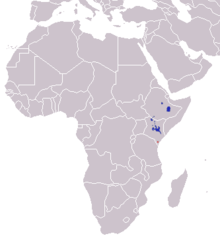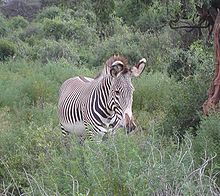Grévy's zebra
| Grévy's zebra[1] Temporal range: [2]
| |
|---|---|

| |
| A Grévy's zebra at Buffalo Springs National Reserve. | |
| Scientific classification | |
| Domain: | Eukaryota |
| Kingdom: | Animalia |
| Phylum: | Chordata |
| Class: | Mammalia |
| Order: | Perissodactyla |
| Family: | Equidae |
| Genus: | Equus |
| Subgenus: | Hippotigris |
| Species: | E. grevyi
|
| Binomial name | |
| Equus grevyi | |

| |
| Grévy's zebra range native introduced | |
Grévy's zebra (Equus grevyi), also known as the imperial zebra, is the largest living wild
The Grévy's zebra live in semi-arid savanna, where they feed on grasses,
Taxonomy and naming
The Grévy's zebra was first described by French naturalist Émile Oustalet in 1882. He named it after Jules Grévy, then president of France, who, in the 1880s, was given one by the government of Abyssinia. Traditionally, this species was classified in the subgenus Dolichohippus with plains zebra and mountain zebra in Hippotigris.[7] Groves and Bell (2004) place all three species in the subgenus Hippotigris.[8]
Fossils of zebra-like equids have been found throughout Africa and Asia in the Pliocene and Pleistocene deposits.[7] Notable examples include E. sanmeniensis from China, E. cautleyi from India, E. valeriani from central Asia and E. oldowayensis from East Africa.[7] The latter, in particular is very similar to the Grévy's zebra and may have been its ancestor.[7] The modern Grévy's zebra arose in the Middle Pleistocene.
Description

The Grévy's zebra is the largest of all wild equines. It is 2.5–2.75 m (8.2–9.0 ft) in head-body with a 55–75 cm (22–30 in) tail, and stands 1.45–1.6 m (4.8–5.2 ft) high at the withers. These zebras weigh 350–450 kg (770–990 lb).[15] Grévy's zebra differs from the other two zebras in its more primitive characteristics.[16]: 147 It is particularly mule-like in appearance; the head is large, long, and narrow with elongated nostril openings;[16]: 147 the ears are very large, rounded, and conical and the neck is short but thick.[17] The zebra's muzzle is ash-grey to black in colour with the lips having whiskers. The mane is tall and erect; juveniles have a mane that extends to the length of the back and shortens as they reach adulthood.[17]
As with all zebra species, the Grévy's zebra's pelage has a black and white striping pattern. The stripes are narrow and close-set, being broader on the neck, and they extend to the hooves.[17] The belly and the area around the base of the tail lack stripes and are just white in color, which is unique to the Grévy's zebra. Foals are born with brown and white striping, with the brown stripes darkening as they grow older.[17]
Range and ecology

The Grévy's zebra largely inhabits northern Kenya, with some isolated populations in Ethiopia.[16]: 147 [17] It was extirpated from Somalia and Djibouti and its status in South Sudan is uncertain.[3] It lives in Acacia-Commiphora bushlands and barren plains.[13] Ecologically, this species is intermediate between the arid-living African wild ass and the water-dependent plains zebra.[13][16]: 147 Lactating mares and non-territorial stallions use areas with green, short grass and medium, dense bush more often than non-lactating mares and territorial stallions.[18]
Grévy's zebras rely on
Behaviour and life history

Adult stallions mostly live in territories during the wet seasons but some may stay in them year round if there's enough water left.[13] Stallions that are unable to establish territories are free-ranging[16]: 151 and are known as bachelors. Mares, young and non-territorial stallions wander through large home ranges. The mares will wander from territory to territory preferring the ones with the highest-quality food and water sources.[23] Up to nine stallions may compete for a mare outside of a territory.[17] Territorial stallions will tolerate other stallions who wander in their territory. However, when an oestrous mare is present the territorial stallion keeps other stallions at bay.[13][16]: 151 Non-territorial stallions might avoid territorial ones because of harassment.[18] When mares are not around, a territorial stallion will seek the company of other stallions. The stallion shows his dominance with an arched neck and a high-stepping gait and the least dominant stallions submit by extending their tail, lowering their heads and nuzzling their superior's chest or groin.[16]: 151
Zebras produce numerous sounds and vocalisations. When alarmed, they produce deep, hoarse grunts. Whistles and squeals are also made when alarmed, during fights, when scared or in pain. Snorts may be produced when scared or as a warning. A stallion will bray in defense of his territory, when driving mares, or keeping other stallions at bay. Barks may be made during copulation and distressed foals will squeal.
Reproduction

Grévy's zebras can mate and give birth year round, but most mating takes place in the early rainy seasons and births mostly take place in August or September after the long rains.

The resident stallions of territories will try to subdue the entering mares with dominance rituals and then continue with courtship and copulation.
Gestation of the Grévy's zebra normally lasts 390 days,[17] with a single foal being born. A newborn zebra will follow anything that moves, so new mothers prevent other mares from approaching their foals while imprinting their own striping pattern, scent and vocalisation on them.[17] Mares with young foals may gather into small groups.[21] Mares may leave their foals in "kindergartens" while searching for water.[21] The foals will not hide, so they can be vulnerable to predators.[13] However, kindergartens tend to be protected by an adult, usually a territorial stallion.[21] A mare with a foal stays with one dominant territorial stallion who has exclusive mating rights to her. While the foal may not be his, the stallion will look after it to ensure that the mare stays in his territory.[26] To adapt to a semi-arid environment, Grévy's zebra foals have longer nursing intervals and wait until they are three months old before they start drinking water.[21] Although offspring become less dependent on their mothers after half a year, associations with them continue for up to three years.[13]
Relationship with humans
The Grévy's zebra was known to the Europeans in
Status and conservation

The Grévy's zebra is considered
There are also an estimated 600 Grévy's zebras in captivity.[28]: 20 Captive herds have been known to thrive, like at White Oak Conservation in Yulee, Florida, United States, where more than 70 foals have been born. There, research is underway in partnership with the Conservation Centers for Species Survival on semen collection and freezing and on artificial insemination.[29]
The Grévy's zebra is legally protected in Ethiopia. In Kenya, it is protected by the hunting ban of 1977. In the past, Grévy's zebras were threatened mainly by hunting for their skins which fetched a high price on the world market. However, hunting has declined and the main threat to the zebra is habitat loss and competition with livestock. Cattle gather around watering holes and the Grévy's zebras are fenced from those areas.
The mesquite plant was introduced into Ethiopia around 1997 and is endangering the zebra's food supply. An invasive species, it is replacing the two grass species, Cenchrus ciliaris and Chrysopogon plumulosus, which the zebras eat for most of their food.[30][31]
References
- OCLC 62265494.
- S2CID 233638447.
- ^ . Retrieved 12 November 2021. Database entry includes a brief justification of why this species is endangered.
- ^ "Appendices". CITES. Retrieved 14 January 2022.
- ^ Oustalet, E. (1882). "Une nouvelle espèce de Zèbre. Le Zèbre de Grévy (Equus revyi)". La Nature. 10 (470): 12–14.
- ^ "Six endangered Grevy's Zebra foals make their debut at the San Diego Zoo Safari Park". San Diego Zoo Global. 30 September 2020. Retrieved 29 September 2022.
- ^ ISBN 978-0-801-87135-1.
- .
- S2CID 233638447.
- ^ PMID 23437078.
- ^ Forstén, Ann (1992). "Mitochondrial‐DNA timetable and the evolution of Equus: of molecular and paleontological evidence" (PDF). Annales Zoologici Fennici. 28: 301–309.
- PMID 2832696.
- ^ ISBN 978-0-520-08085-0.
- S2CID 18388598.
- ^ Huffman, B. "Grevy's zebra". Ultimate Ungulate.
- ^ ISBN 9780226437224.
- ^ JSTOR 3504222.
- ^ S2CID 12625704.
- JSTOR 2845470.
- ^ Youth, H. (2004). "Thin Stripes on a Thin Line". Zoogoer. 33 (November/December 2004). Archived from the original on 26 October 2005.
- ^ S2CID 54252836.
- .
- ^ S2CID 206771095.
- ^ ISBN 0123808944
- .
- JSTOR j.ctt7zvwgq.
- ^ "25 Cents, Eritrea". en.numista.com.
- ^ ISBN 978-2-831-70647-4.
- ^ "Grevy's Zebra". Retrieved 21 June 2013.
- ^ Platt, John R. "Devil Tree Threatens the World's Rarest Zebras". Retrieved 7 August 2015.
- S2CID 83558974.
External links
- "Wildlife Grévy's Zebra" – summary from the African Wildlife Foundation
- Images and footage of Grévy's zebra from ARKive.org
- "To Catch a Zebra" Archived 14 February 2021 at the Wayback Machine by Brian Jackman – story of catching endangered Grévy's zebra for relocation
- "Why are the Grevy's Zebras in Trouble?" – Rich Blundell reports from Kenya
- Grevy's Zebra Trust – a Kenyan organization dedicated to preserving the Grévy's zebra

